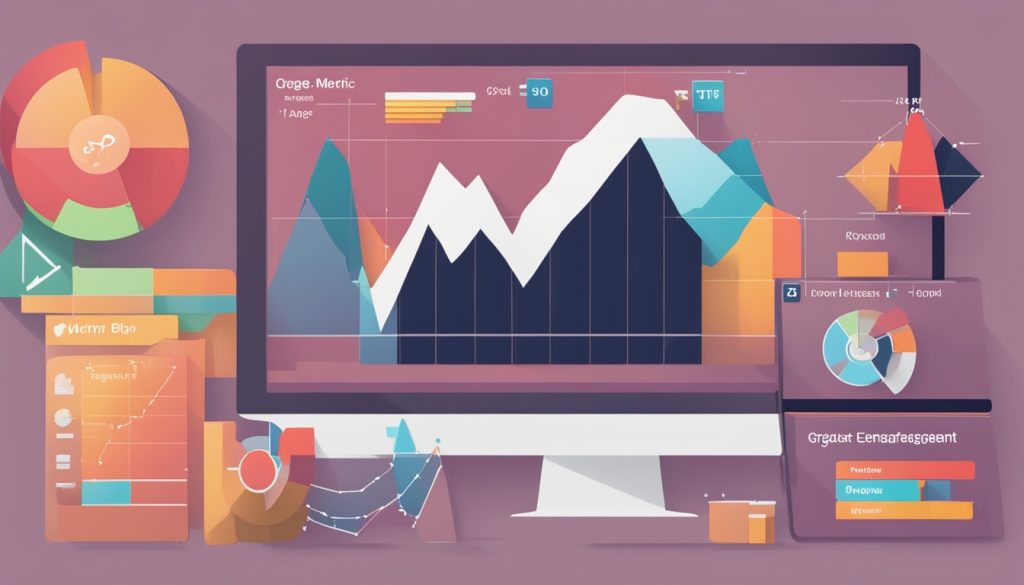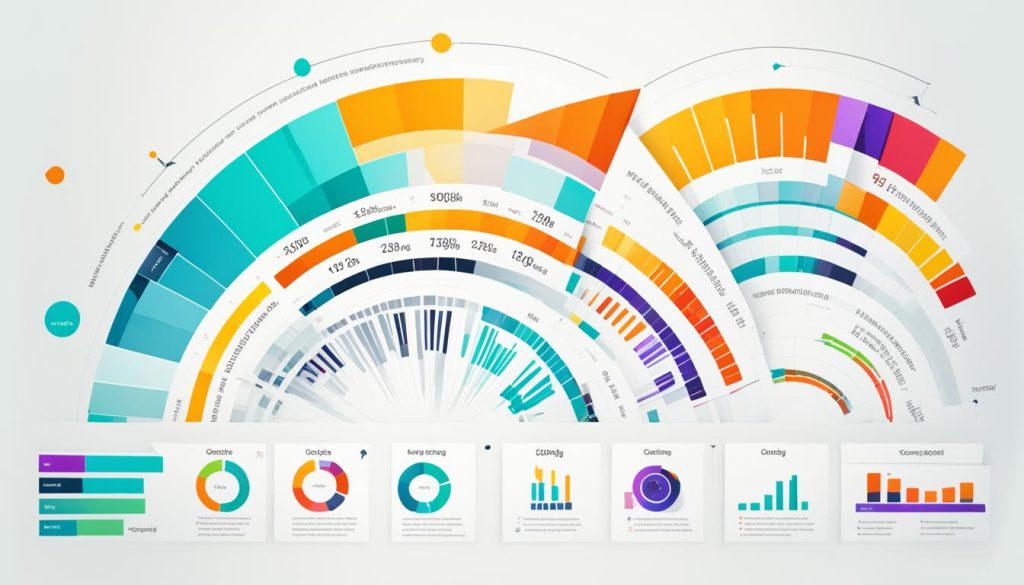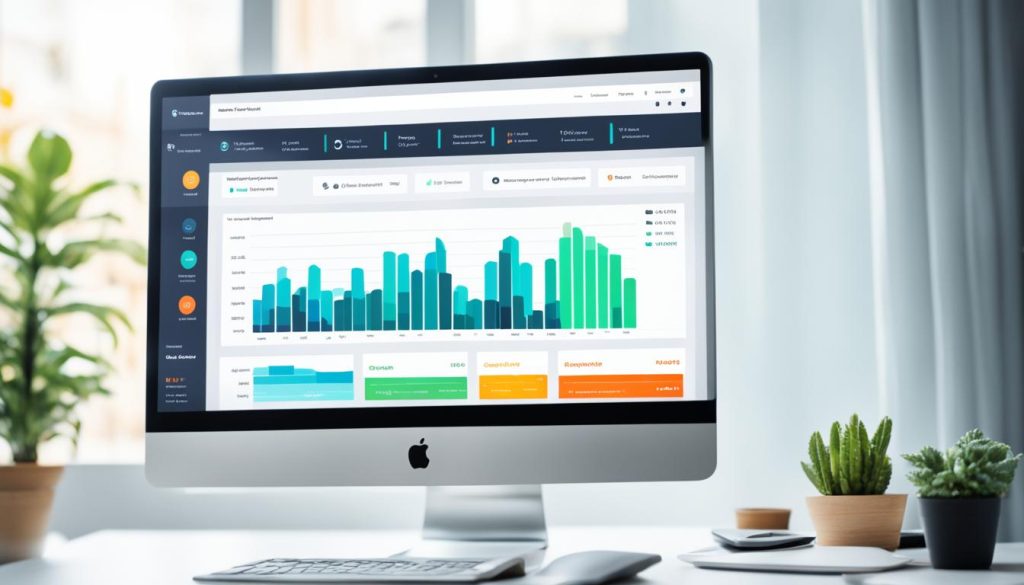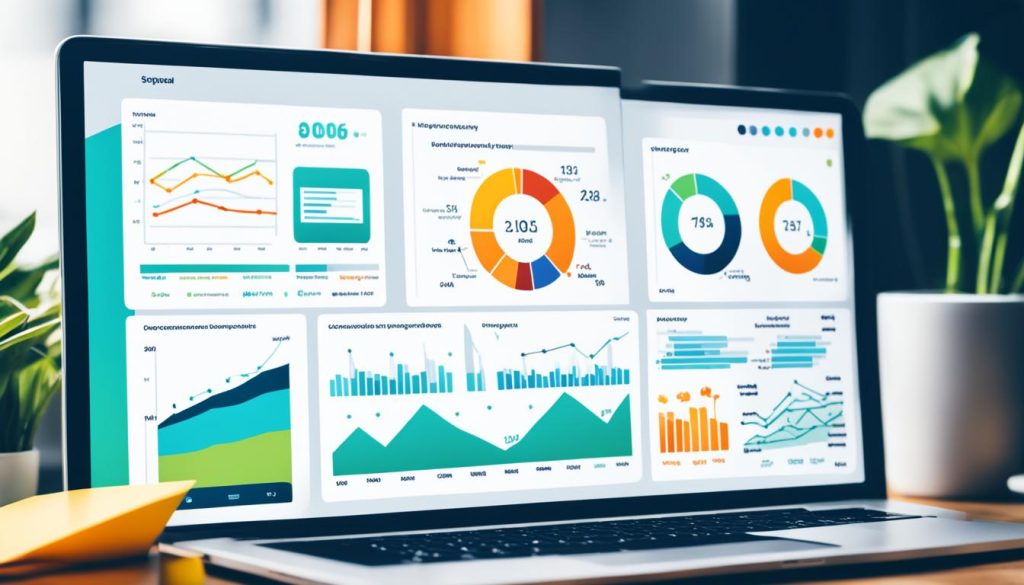Ever wondered how top bloggers stay ahead? It’s all about mastering analytics and metrics. These tools are key to growing your blog. But what are they, and how can you use them?
Shockingly, 95% of bloggers don’t track their performance well. This means they miss out on important insights that could change their strategy. Don’t be one of them. Start learning about understanding blog analytics, blog traffic metrics, and content performance analysis. This will help you succeed online.
This guide will cover audience engagement tracking, SEO and search insights, social media impact, conversion rate monitoring, and user behavior analysis. Learn how to use these tools for a data-driven content strategy. This way, you can track your ROI and make smart choices for your blog.
What Are Metrics in Blogging?
Metrics are the numbers that show how well your blog is doing. They help you see how your content is doing, how people interact with it, and where you can improve. By keeping an eye on these blog metrics, you can make smart choices to grow your audience.
Key Metrics for Bloggers
Some important metrics for bloggers are:
- Website traffic
- Page views
- Bounce rate
- Time on page
- Social media shares
- Email subscribers
- Conversion rates
These key performance indicators (KPIs) give you insights into your blog’s success and how engaged your audience is. By looking at these data-driven metrics, you can make smart choices to improve your content. This helps you grow your audience and make your content better.
| Metric | Description | Importance |
|---|---|---|
| Website Traffic | The number of visitors to your blog | Shows how well your content reaches people |
| Page Views | The total number of pages viewed by your visitors | Shows how engaging and interesting your content is |
| Bounce Rate | The percentage of visitors who leave your site after seeing just one page | Helps you see where to improve your content and user experience |
| Time on Page | The average time visitors spend on each page of your blog | Shows how engaged and satisfied your visitors are with your content |
| Social Shares | The number of times your content is shared on social media | Shows how well your content spreads and goes viral |
| Email Subscribers | The number of people who signed up for your email newsletter | Shows you have a dedicated audience and potential for more conversions |
| Conversion Rate | The percentage of visitors who do what you want them to, like buy something or sign up | Tells you how well your content and marketing work |
By keeping an eye on these blog metrics, you can learn a lot about your blog’s success. This helps you make smart choices to improve your content and grow your audience.
The Role of Analytics in Blogging
Blogging is more than just writing. It’s about knowing your readers, checking how well you’re doing, and using data to make your blog better. Blog analytics help with this. They let you see how your readers act and how well your content works.
Looking at your blog’s analytics gives you key customer insights. This info helps shape your content strategy and audience segmentation. You’ll see which topics and formats get the most attention. You’ll also see how your readers interact with your blog over time.
Data analysis of your blog’s metrics shows how your audience behaves. This helps you make your content better and improve its performance. This info is crucial for better marketing, improving user experience, and getting more traffic, leads, and conversions.
Using blog analytics helps you make smart choices for your blog. You can make sure your content hits the mark with your target audience and meets your business goals.

Difference Between Metrics and Analytics
In the world of blogging, knowing the difference between metrics and analytics is key. These terms are often mixed up, but they mean different things. They work together to give you a full view of your blog’s success.
Metrics are numbers that show how well your blog is doing. They include things like website visits, bounce rate, and how many people take action. These data measurements help you see what’s happening on your blog.
Analytics is about looking at these metrics to understand them better. It helps you make data-driven decisions. Analytics takes the raw data and adds context. This helps you improve your blog’s performance tracking and business intelligence.
To sum it up, metrics are the numbers. Analytics is what you do with those numbers to get useful insights. By using both, you can make smart choices that help your blog grow.
Understanding Blog Analytics
Analyzing your blog’s performance is key to making smart decisions for growth. Blog analytics include tools and methods that give deep insights into your audience, content, and site performance. By knowing the various types of blog analytics, you can create a strong, data-driven plan to boost your blog’s success.
Types of Blog Analytics
Blog analytics fall into several main categories, each with its own goal and method:
- Descriptive analytics summarizes past events and behaviors, giving a clear view of what happened on your blog.
- Diagnostic analytics digs into the data to find out why certain trends happen, helping you spot the main causes.
- Predictive analytics uses past data and models to guess future audience behavior and what they might need.
- Prescriptive analytics takes it further, using data and models to suggest the best ways to improve your blog’s performance.
Knowing these types of blog analytics helps you craft a detailed, data-driven insights strategy. This way, you can make your blog more effective and reach your goals.

Setting Up Analytics for Your Blog
Tracking your blog’s performance is key to making smart choices and growing it. Google Analytics is a free tool that gives you deep insights into your blog’s traffic and user behavior. It’s easy to set up and can help you make your content better and improve the user experience.
There are also other web analytics tools like Kissmetrics and Mixpanel with more features. They offer deeper data tracking capabilities. You might want to look into these if your blog has specific needs or goals. The important thing is to set up your blog analytics right to get accurate and useful data.
- Define your key metrics: Pick the most important metrics for your blog, like pageviews, unique visitors, bounce rate, and conversion rates.
- Implement tracking codes: Use the instructions from your analytics platform to add the tracking codes to your blog.
- Customize your settings: Adjust your analytics settings to fit your needs, like creating custom dashboards, setting goals, and segmenting your audience.
- Monitor and analyze your data: Check your blog’s performance data often to spot trends, find insights, and make informed decisions to improve your content and marketing.
By setting up blog analytics right, you’ll have the tools and insights to boost your blog’s performance. You’ll be able to engage your audience better and drive your blog’s growth and success.

Analyzing Your Blog’s Performance
Success with your blog isn’t just about tracking metrics. It’s about finding and watching your key performance indicators (KPIs). These are the metrics most important for your blog’s growth and profits.
Important KPIs include website traffic, bounce rate, time on page, social media engagement, email subscriber growth, and conversion rates. By checking these KPIs often and seeing how they help your business goals, you can make smart choices. You can improve your content, tweak your marketing, and grow your blog audience.
Key Performance Indicators (KPIs)
It’s key to track the right KPIs for blog performance analysis and smart data-driven decision making. Important KPIs for bloggers are:
- Website traffic (sessions, unique visitors, page views)
- Bounce rate and time on page
- Social media engagement (likes, shares, comments)
- Email subscriber growth
- Conversion rates (lead generation, sales, etc.)
By keeping an eye on these metrics and seeing how they help your content optimization and audience growth goals, you can make choices to boost your blog’s success. This leads to lasting success.

Interpreting Metrics and Analytics
Unlocking your blog’s true potential requires data interpretation, metrics analysis, and analytics insights. Just collecting data isn’t enough. You must dig deeper to find trends and understand what drives your blog’s success.
By sharpening your skills in data interpretation, you can make better decision-making choices. This leads to better performance optimization for your blog. Let’s dive into how to interpret metrics and analytics for blog success.
- Identify Key Metrics: Focus on important metrics like page views, unique visitors, bounce rate, and engagement rates. These should match your blog’s goals.
- Analyze Trends and Patterns: Search for patterns in your data. Notice changes and what causes them. This helps you understand your blog’s performance better.
- Contextualize the Data: Don’t just look at the numbers alone. Think about outside factors like seasonal changes and what your competitors are doing. This gives you a full picture of your blog’s success.
- Draw Actionable Insights: Turn the data into insights that help you plan your content and marketing. Find areas to improve and chances to grow.
| Metric | What It Tells You | How to Interpret |
|---|---|---|
| Page Views | The total number of pages viewed by your audience | More page views mean more engagement and interest. Look for trends to see what content works best. |
| Unique Visitors | The number of individual users who have visited your blog | Watching unique visitors helps you see if your blog is growing. Look for changes to understand what affects your audience. |
| Bounce Rate | The percentage of visitors who leave your blog after viewing only one page | A high bounce rate means your content or user experience might be off. Work on making your content better to lower bounce rates. |
Data interpretation is more of an art than a science. By improving your skills in metrics analysis and analytics insights, you can make smarter decision-making choices. This leads to better performance optimization for your blog, ensuring it keeps doing well.

Using Analytics to Improve Your Blog
Using data to guide your blog can change the game. By looking at your blog’s analytics, you can make smart choices. These choices help increase audience engagement, make the user experience better, and boost your conversion rates and ROI.
One way to use analytics is to make your content better match what your audience likes. Look at page views, bounce rates, and time spent on page. This helps you see what topics and styles work best. Then, you can make more content that keeps readers interested and coming back.
Analytics also help improve the user experience. You can make your site easier to navigate, faster, and more intuitive. This makes visitors happy and can lead to more conversions. A good user experience is key for getting leads, sales, and other goals.
Also, tracking your important metrics and conversion rates gives you insights into your content’s ROI. This lets you make choices based on data. You can use your resources better, making your blog grow sustainably.
The strength of analytics is turning your blog into a place that focuses on its audience. With a data-driven approach, you can increase engagement, improve the user experience, and get better conversion rates. This leads to more success for your blog.
The Importance of Tracking the Right Metrics
It’s key to keep an eye on the relevant metrics to understand how your blog is doing. You should focus on metrics that matter to your business goals and your audience. Important metrics include website traffic, engagement rate, time on page, social media engagement, email subscriber growth, and conversion rates.
Identifying your key performance indicators (KPIs) helps you see what’s working and what’s not. This lets you make smart changes to your blog for better results. It’s a way to grow your audience more effectively.
- Prioritize metrics that align with your business objectives
- Monitor trends and changes in your KPIs over time
- Use data to improve your content optimization efforts
- Keep tweaking your strategies based on what you learn
| Metric | Importance |
|---|---|
| Website Traffic | Understand the overall reach and visibility of your blog |
| Engagement Rate | Measure the level of interaction and interest from your audience |
| Time on Page | Gauge the depth of engagement and the value of your content |
| Social Media Engagement | Assess the impact and reach of your content on social platforms |
| Email Subscriber Growth | Indicate the effectiveness of your email marketing efforts |
| Conversion Rates | Measure the success of your calls-to-action and the value you provide |
Tracking the right relevant metrics helps you make smart choices for your blog. By keeping an eye on your key performance indicators (KPIs), you can improve your content and strategies. This way, you’ll know what your audience likes, making your content more engaging and valuable.
Combining Metrics and Analytics for Better Decisions
To really get the most out of your blog’s data, you need to blend your metrics and analytics well. Metrics give you the numbers, while analytics add the context you need for data-driven decision making. By linking your metrics and metrics and analytics integration, you get a full picture of how your blog is doing. This helps you spot trends and patterns, and plan better performance optimization strategies.
This approach helps you make smarter, more effective choices for your blog. Using both metrics and analytics, you can find key insights. These insights help shape your content, improve your marketing, and lead to better outcomes for your blog.
Success comes from balancing data insights with your own knowledge of your audience. By mixing these, you can make choices that are both strategic and based on data. This will help move your blog forward.
Tools and Resources for Blog Analytics
Using the right blog analytics tools is key to understanding and improving your blog’s performance. These tools offer deep insights into your website’s traffic and how users interact with your content. They help bloggers see what works and what doesn’t.
Google Analytics is a top choice, giving you a full picture of your blog’s traffic and user behavior. For tracking customer journeys, Kissmetrics is great. Mixpanel and Amplitude focus on how users engage with your content. Heap Analytics provides detailed insights into user behavior.
There are also many online resources and communities to help you improve your skills. Tools like Tableau, Power BI, and Looker make complex data easy to understand. They turn your blog’s data into clear, useful information.
| Tool | Key Features | Pricing |
|---|---|---|
| Google Analytics | Website analytics, user behavior, content performance | Free |
| Kissmetrics | Customer journey analytics, user engagement | Starts at $299/month |
| Mixpanel | User engagement metrics, conversion tracking | Starts at $25/month |
| Amplitude | Behavioral analytics, product analytics | Starts at $25/month |
| Heap Analytics | Behavioral analytics, user journey tracking | Starts at $999/month |
With the right blog analytics tools, you can understand what your audience likes and how they interact with your content. This helps you make smart choices to grow your blog.
Case Studies: How Successful Bloggers Use Analytics
Many top successful bloggers use analytics to grow their blogs. By looking at analytics case studies, you can learn a lot. This helps you make data-driven decisions for your blog’s growth and success.
Jon Loomer, a Facebook marketing expert, uses analytics to make his content better. He targets his audience and checks the ROI of his marketing. Neil Patel, a big name in digital marketing, also uses analytics. He makes data-driven content strategies to boost audience engagement and get results for his clients.
These bloggers know how analytics help with audience engagement and ROI measurement. They look at their data closely. This helps them make smart choices for their blogs’ growth.
By learning from these successful bloggers and their analytics, you can create a data-driven content strategy. This strategy will connect with your audience and bring real results to your blog. Use the power of analytics to take your blogging to the next level.
Common Challenges in Blog Analytics
Blog analytics is a powerful tool for growth and success. Yet, bloggers face hurdles. They struggle with data accuracy, making sense of insights, dealing with resource limitations, and matching their analytics with organizational goals and priorities.
Getting accurate and reliable data is key for bloggers. Wrong or missing data can lead to bad decisions. They need to check and improve how they collect and analyze data.
Interpreting the data from blog analytics is another big challenge. Bloggers must know how to turn data into strategies to better their content and performance.
- Limited budget or tech skills can stop bloggers from using analytics tools well and making data-driven plans.
- It’s hard to match organizational goals with blog analytics insights. Bloggers must make sure their analytics fit with the company’s big goals.
To beat these challenges, bloggers should keep up with the latest in analytics. They should always check and improve their data work. And they should work with different teams to make sure their analytics support the company’s strategy.
| Challenge | Description |
|---|---|
| Data Accuracy | Ensuring the accuracy and reliability of data collected through blog analytics |
| Data Interpretation | Translating the insights gained from analytics into actionable strategies |
| Resource Limitations | Overcoming budget or technical expertise constraints to effectively leverage analytics tools |
| Organizational Alignment | Aligning blog analytics initiatives with the broader goals and priorities of the organization |
Navigating the Challenges
To beat these common blog analytics challenges, bloggers need to stay updated on best practices. They should always be improving their data work. And they should work with different teams to make sure their analytics support the company’s strategy.
The Future of Blog Analytics
The world of digital marketing and content creation is always changing. This means the role of blog analytics will change too. Soon, we’ll see more artificial intelligence and machine learning in blog analytics. This will make analytics more advanced and personal.
There’s also a big focus on keeping data private and using it ethically. Bloggers will need to be careful with how they collect and use their data. By keeping up with new trends in blog analytics, you can stay ahead in the digital world.
The future of blog analytics is full of exciting changes. We’ll see more predictive analytics and personalized content suggestions. By using these new tools, you can better connect with your readers, improve your content, and grow your blog sustainably.

